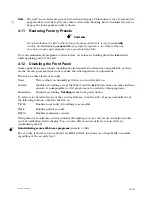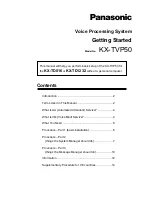
4-11
Rev 2.2, 10/31/94
Lowering the filter frequency, in lowpass mode) makes the dynamics section less responsive to
high-frequency sounds. This may be useful for preventing sibilance or high-frequency noise
(hiss, clicks, etc.) from triggering the dynamics section.
4.5.7.2 Expander knee control
The point in the downward expander’s gain curve immediately below threshold is known as the
knee. The width of the knee may be altered to make the transition to the expander’s ultimate
slope more or less gradual. Edit buffer 49 controls the downward expander’s knee width.
4.5.7.3 Compressor knee control
The point in the compressor’s gain curve immediately above threshold is known as the knee.
The width of the knee may be altered to make the transition to the compressor’s ultimate slope
more or less gradual. Edit buffer 55 controls the compressor knee width.
4.5.7.4 AGC absolute threshold
The AGC normally acts as a compressor having its threshold level set
very
low. This parameter
(edit buffer 56) controls just how low the actual threshold is. Below this level, there is no AGC
action.
4.5.7.5 AGC knee control
The point in the AGC’s gain curve immediately above threshold is known as the knee. The
width of the knee may be altered to make the transition to the AGC’s ultimate slope more or
less gradual. Edit buffer 60 controls the AGC knee width.
4.5.7.6 ARM peak release TC
This parameter (edit buffer 62) affects the recovery time of the auto-release monitor (ARM)
subsystem. Normal settings are in the 1 to 3 second range and the default setting is 2.5
seconds. Refer also to Section 4.5.7.7.
4.5.7.7 ARM integration TC
This parameter (edit buffer 63) affects the signal level history of the ARM subsystem. Shorter
time constants require higher signal peak-to-average ratios to trigger the AGC hold function
(thereby releasing the gain reduction). This time constant and the time constant used for offset
62 should be in the same range of 1 to 3 seconds.
4.5.7.8 ARM Signal/Noise threshold
The AGC uses a signal/noise detector (ARM or Auto-Release Monitor) to decide when to allow
the AGC compressor’s gain reduction to recover to it’s no-signal value. The detector uses the
peak-to-average ratio of the signal to decide whether the signal is noise or not noise. Raising
the ARM signal/noise threshold (edit buffer 64) causes the detector to reject signals lacking
much peak content. Lowering the threshold makes the detector less picky, eventually allowing
noise to pass as signal.
4.5.7.9 Log converter time constant
The dynamics section’s log converter converts the audio signal into a logarithmic representation
of its signal level. The log converter time constant is a simple time constant at the output of the
log converter. The time constant sets a minimum attack and release time for any signal. Some
smoothing is necessary to prevent the compressor (or other dynamics processor) from trying to
follow the envelope of low-frequency signals.; Edit buffer 66 controls the time constant.
4.5.7.10 Lookahead delay time
Overshoot is a problem with any compressor that is caused by the control signal arriving at the
gain-controlled element (VCA in analog units) after the leading edge of the audio signal. A
simple remedy for overshoot is to slightly delay the audio before it gets to the gain-controlled
Summary of Contents for 601
Page 46: ...4 18 Rev 2 2 10 31 94 This page is blank believe it or not ...
Page 48: ...4 20 Rev 2 2 10 31 94 Notes ...
Page 50: ...5 2 Rev 2 2 10 31 94 Notes ...
Page 70: ...7 16 Rev 2 2 10 31 94 Notes ...
Page 72: ...8 2 Rev 2 2 10 31 94 Notes ...
Page 74: ...9 2 Rev 2 2 10 31 94 Notes ...
Page 78: ...11 2 Rev 2 2 10 31 94 Notes ...
Page 126: ...D 12 Rev 2 2 10 31 94 Notes ...
Page 138: ...G 8 Rev 2 2 10 31 94 Notes ...
















































